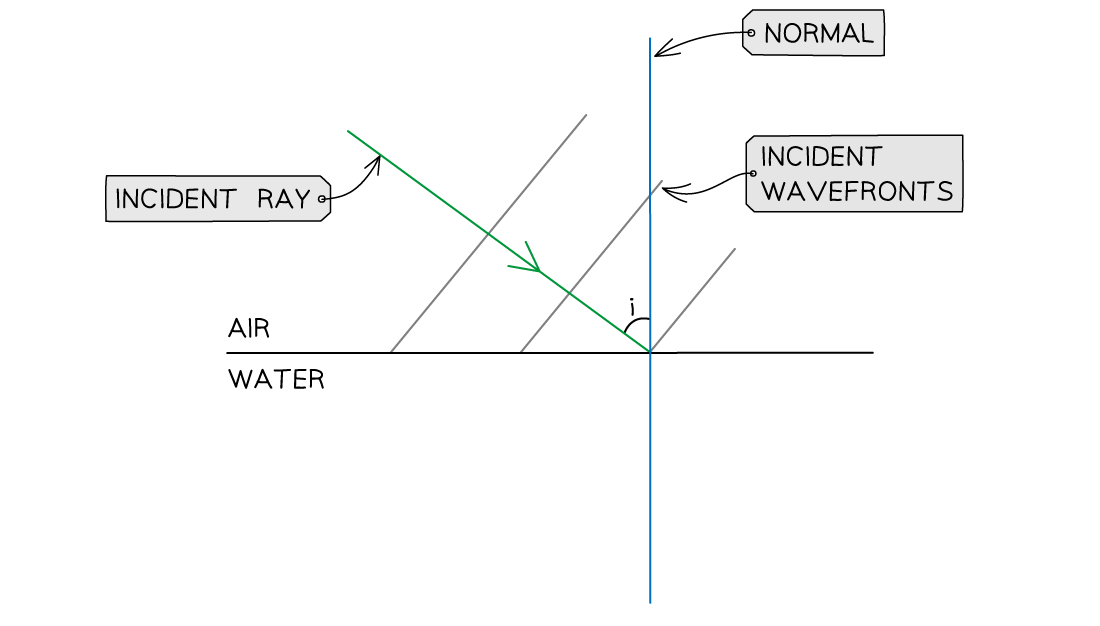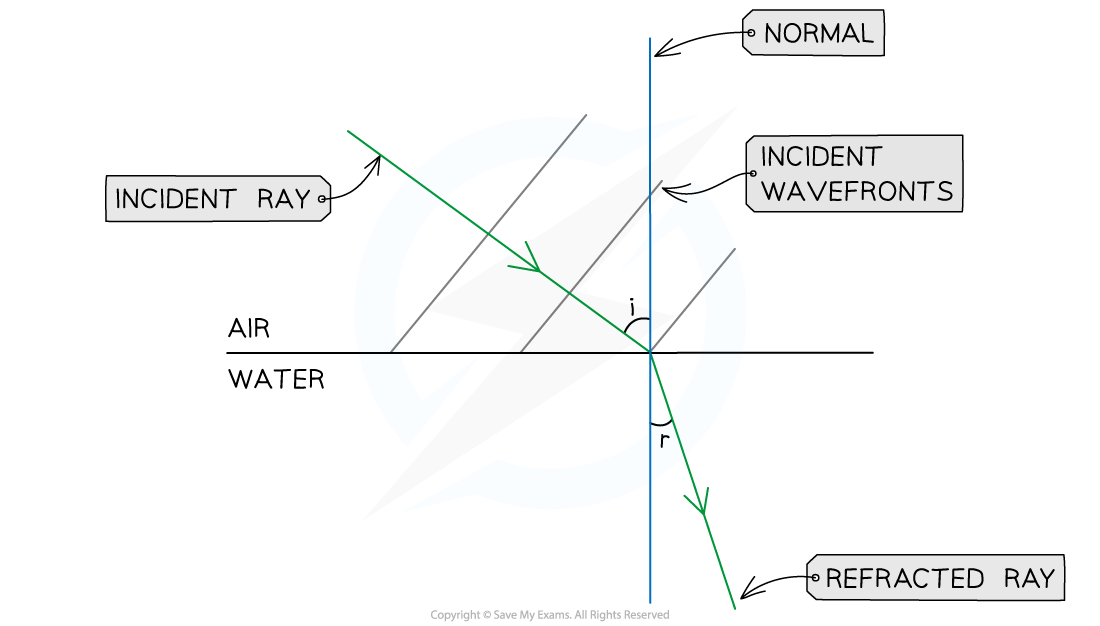Snell's Law
- When light crosses the boundary between two media with different optical densities, it refracts
- At the boundary, the light undergoes a change in direction
- The change in direction depends on the difference in density of the media the light rays pass between:
Air → glass (less dense → more dense):
-
- Light bends towards the normal
- The angle of incidence is greater than the angle of refraction
Glass → air (more dense → less dense):
-
- Light bends away from the normal
- The angle of refraction is greater than the angle of incidence
When passing along the normal (perpendicular):
-
- The light does not bend at all
- This would be described as transmission
- The light does not bend at all

Refraction of light through a glass block
- When light passes from a less dense medium to a more dense medium, (e.g. air → glass):
- The refracted light has a lower speed and a shorter wavelength than the incident light
- When light passes from a more dense medium to a less dense medium (e.g. glass → air):
- The refracted light has a higher speed and a longer wavelength than the incident light
- When more than one boundary is shown in a refraction ray diagram, (e.g. light passing through a glass block):
- The new incident ray (at the glass-air boundary) is equal to the angle of refraction (at the air-glass boundary)
- The refracted ray is equal to the original angle of incidence

A light ray refracted at the air-glass boundary
- Together with refraction, reflection might also occur
- When light travels from a less optically dense medium into an optically denser medium, both reflection and refraction always occur
- Light has to be reflected from the object to the eye in order for objects to be visible
- Some of the energy in the incident light is reflected back, while some is transmitted
Refractive Index
- Transparent media have different optical densities
- Light is transmitted through these media at different speeds
- The refractive index, n, of a transparent medium is a measure of its optical density, and can be calculated as follows:
- Where:
- n = absolute refractive index of the medium
- c = speed of light in vacuum in metres per second (m s–1)
- v = speed of light in the medium in metres per second (m s–1)
- The value of the speed of light in a vacuum is c = 3.00 × 108 m s–1, as given in the data booklet
- This is a property of the material
- Note that, being a ratio, the absolute refractive index is a dimensionless quantity
- This means that it has no units
- The refractive index of air can be assumed to be n = 1
- Because the speed of light will always be faster than the speed of light in a medium, the refractive index of any other transparent medium is n > 1
Snell's Law
- Snell's Law is given by:
- Where:
- n = absolute refractive index
- θ = angles of incidence and refraction
- v = speed of light in medium
- Snell's Law describes the angle at which light meets the boundary and the angle at which light leaves the boundary, so that the light travels through the media in the least amount of time
- Light can travel through medium 1 at a speed of v1 due to the optical density n1 of that medium
- Light will approach the boundary at angle θ1
- This is the angle of incidence
- Light can travel through medium 2 at a speed of v2 due to the optical density n2 of that medium
- Light will leave the boundary at angle θ2
- This is the angle of refraction

Snell's Law
- To illustrate this, there is a classic thought experiment that uses Fermat's Principle of Light
- Fermat's Principle of Light states that light will travel between two points along the path that will take the least amount of time
- A lifeguard on a beach sees a swimmer in need of rescue. They can run at 5 m s−1 on the sand and swim at 2 m s−1 in the water. What is the fastest path to take?
- The lifeguard could run on the sand straight to the water and then swim to the person
- The lifeguard could run on the sand until they are parallel to the person, and then swim directly out to them
- The lifeguard could run and then swim diagonally in a path that is a straight line from his position in the sand to the position of the swimmer in the water
- Or, the lifeguard could run diagonally, but so that more of the distance covered is in the sand than in the water
- Some permutation of this answer is where the fastest path will be found

Thought experiment: A lifeguard needs to find the fastest path to a swimmer in trouble
- Using this thought experiment, it can be seen that Snell's Law emerges

Snell's Law in the context of the thought experiment
- Snell's Law can also be given as:
- This form of Snell's Law can often be more convenient to use
- When the incident ray is perpendicular to the surface of the boundary, its speed changes, but its direction does not
- Snell's Law can be used to explain this:
- The angle of incidence is zero,
= 0, therefore,
- Since,
- Anything multiplied by zero is zero, therefore,
- Hence, the refracted angle θ2 must also be zero
- So, there is transmission without refraction
- The angle of incidence is zero,

Light travelling along the normal to the boundary between material 1 and material 2
Worked example
Wavefronts travel from air to water as shown. Add the refracted wavefronts to the diagram.

Answer:
Step 1: Add the incident ray to mark the direction of the incident waves
- The incident ray must be perpendicular to all wavefronts
- Remember to add an arrow pointing towards the air-water boundary

Step 2: Add the normal at the point of incidence
- Mark the angle of incidence (i) between the normal and the incident ray

Step 3: Draw the refracted ray into the water
- Water is optically denser than air
- The refracted ray must bend towards the normal
- Mark the angle of refraction (r) between the normal and the refracted ray
- By eye, i > r

Step 4: Add three equally spaced wavefronts, all perpendicular to the refracted ray
- The refracted wavefronts must be closer to each other than the incident wavefronts, since:
- The speed v of the waves decreases in water
- The frequency f of the waves stays the same
- The wavelength λ of the waves in water is shorter than the wavelength of the waves in air λW < λA, since v = fλ

Worked example
Light travels from air into glass. Determine the speed of light in glass.
- Refractive index of air, n1 = 1.00
- Refractive index of glass, n2 = 1.50
Answer:
Step 1: Write down the known quantities
- n1 = 1.00
- n2 = 1.50
- From the data booklet, c = 3 × 108 m s–1 (speed of light in air)
Step 2: Write down the relationship between the refractive indices of air and glass and the speeds of light in air (v1) and glass (v2)
![]()
Step 3: Rearrange the above equation to calculate v2

Step 4: Substitute the numbers into the above equation
![]()
v2 = 2 × 108 m s–1
Worked example
A light ray is directed at a vertical face of a glass cube. The angle of incidence at the vertical face is 39° and the angle of refraction is 25° as shown in the diagram.

Show that the refractive index of the glass is about 1.5.
Answer:


Exam Tip
Always double-check if your calculations for the refractive index are greater than 1. Otherwise, something has definitely gone wrong in your calculation! The refractive index of air might not be given in the question. Always assume that nair = 1
Make sure your calculator is always in degrees mode for calculating the sine of angles!
Always check that the angle of incidence and refraction are the angles between the normal and the light ray. If the angle between the light ray and the boundary is calculated instead, calculate 90 – θ (since the normal is perpendicular to the boundary) to get the correct angle


